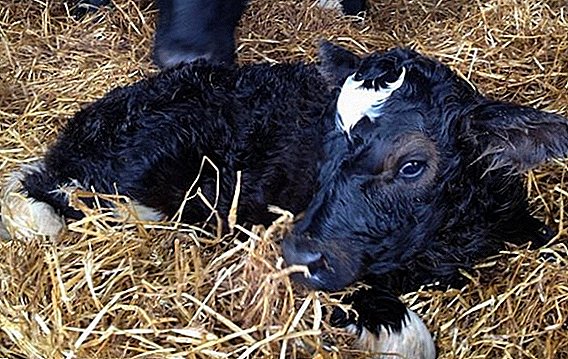 "Affectionate calf two queens sucks" - the validity of this saying is not in doubt as long as the calf does not get sick with bronchopneumonia. During the course of this disease and even after its passage, the calf is not only two, but also sucks one uterus. Not being fatal, this disease, however, is in second place in the frequency of manifestations after gastrointestinal problems in young cattle and causes significant damage to livestock. How to level it, and will be discussed below.
"Affectionate calf two queens sucks" - the validity of this saying is not in doubt as long as the calf does not get sick with bronchopneumonia. During the course of this disease and even after its passage, the calf is not only two, but also sucks one uterus. Not being fatal, this disease, however, is in second place in the frequency of manifestations after gastrointestinal problems in young cattle and causes significant damage to livestock. How to level it, and will be discussed below.
What is this disease
Veal bronchopneumonia, differing in non-communicable etiology, that is, arising in a non-infectious way, and as a result, for example, hypothermia of the body, is characterized by an inflammatory process affecting the bronchi and alveoli. Then this painful process rapidly spreads to other respiratory organs. 
Causes
In the absence of a pronounced infectious component in the disease of young cattle with bronchopneumonia, a whole complex of other causes emerges that lead to this disease:
- Animals are in a close room in a crowded state.
- The air surrounding the animals due to poor ventilation is polluted with ammonia and hydrogen sulfide.
- Low temperature, high humidity and no litter, leading to colds.
- Degradation of the respiratory organs due to lack of movement.
- Excess stressful situations.
- Poor quality food.
- Vitamin A and D deficiency
- Disturbance of the thermoregulation system in calves that have been exposed to heat for a long time.
- Diseases of the gastrointestinal tract, which are not cured for a long time.
Did you know? If milk feeding a calf living on a farm or on a rural farmstead lasts up to three months of age, accompanied by different feed additives at an even earlier age, then in natural conditions the calves are fed with milk for three years.
Forms and symptoms
This disease is uneven, showing different symptoms and sharing in severity into different forms in the form:
- acute;
- subacute;
- chronic.

Sharp
This form is characterized by the rapid development of the disease for about 12 days and is characterized by:
- loss of animal appetite and lethargy in behavior;
- a temperature rise of up to +42 ° С by 2-3 days of illness;
- the appearance of shortness of breath;
- the occurrence of a sharp dry cough;
- swelling of the nasal mucosa;
- discharge from the nose of mucus containing purulent elements;
- leukocytosis found in the blood during its analysis.

Subacute
In this form of bronchopneumonia, the disease has a long duration in time, reaching a crescent or even a month and being characterized by:
- the depressed state of the animal, its loss of appetite and general weakness;
- weight loss;
- normal daytime temperature and a slight increase in the evening;
- frequent and wet cough;
- shortness of breath;
- intestinal function disorder caused by intoxication;
- hard bronchial breathing while listening.
When growing calves, you can also experience diseases such as diarrhea and colibacillosis, as well as diseases of the joints.
Chronic
In case of untimely or incorrect treatment of previous forms of the disease, the calf may develop a chronic form of bronchopneumonia, in which the following symptoms are observed:
- persistent coughing;
- nasal discharge of serous exudate;
- slow weight gain;
- periodic normalization of appetite;
- listening in the lungs dry rales.

Diagnostics
When diagnosing the disease after an external examination of the animal and studying its conditions, the veterinarian proceeds to listen to heart sounds and respiratory functions. In addition, blood tests and fluoroscopy are performed.
The main task here is to eliminate the infectious nature of the disease.
Did you know? On average, cows live to be twenty years old, while the age of bulls is five years shorter.
Since there are several diseases that are similar in symptoms to bronchopneumonia, the specialist should rule out the disease:
- diplococcal infection;
- mycosis;
- salmonellosis;
- mycoplasmosis;
- ascariasis;
- viral infections.

Pathological changes
Bronchopneumonia, affecting primarily the calf's respiratory system, then spreads to other organs of the animal, leading to their change:
- the respiratory system performs its functions worse and worse, allowing a lot of dust, ammonia and water vapor to the lungs, which leads to a respiratory system disease;
- disrupts the activity of the cells of the nervous system;
- immunity decreases;
- Histamine and lysozyme levels fall in the body;
- there is stagnation of blood in the lungs;
- decreases the tone of blood vessels;
- there is a drop in blood pressure;
- the resulting dystrophy affects the heart muscle and liver;
- increased concentration of hydrochloric acid occurs in the stomach;
- kidneys reduce their filtering functions.
It will also be useful for you to learn how to choose the right calf, how to feed it, and also why the calf is sluggish and does not eat well.
Treatment methods for bronchopneumonia in calves
Although this disease has been studied by specialists quite deeply, there is no single universal remedy for fighting it. Depending on the severity of the disease, its various forms of occurrence, certain treatment methods are selected. 
Traditional treatment
Despite the fact that calf bronchopneumonia is not infectious in nature, a sick animal should still be separated from the rest of the herd. In the stable, the sick animal should be clean and dry, a soft litter should be laid on the floor, and the amount of vitamin and mineral supplements should be at least twice as high.
Since the respiratory system suffers from this disease, in the summer period, the sick calf is best kept in the fresh air under a canopy.
Although bronchopneumonia is not infectious in nature, the disease nevertheless develops with the active participation of microorganisms.
Good old antibiotics, which have traditionally and quite successfully been used for years for colds, have now noticeably decreased their effectiveness, since microorganisms have accumulated resistance to many of them.
Important! Treatment of bronchopneumonia calves should only be practiced by veterinarians. Self-activity in this matter is fraught with undesirable consequences.
In such a situation, it is very difficult for a livestock breeder who has resorted to self-treatment of the calf with traditional medicines, to monitor the success of the treatment, and here there is a danger that the disease will turn into a subacute or even chronic form. 
Etiotropic therapy
The essence of this method of treatment is to create a high concentration of drugs directly in the localization of inflammatory processes.
This therapy is quite effective in acute and subacute forms of the disease, but it is less successful in the chronic course of the disease. Treatment is based on the use of the cephalosporin and macloid groups of drugs. In addition, animals are also healed with sulfonamides, Tetracycline and Levomycetin.
Intravenous administration of 7-12 ml Streptomycin per kilogram of animal weight has proven itself well: 5 g of the drug is diluted in 200 ml of 9% saline, and the resulting preparation is injected for three days once a day.
Intratracheal therapy
In this method of treatment, drugs are injected directly into the trachea of the animal by means of a probe or needle. To do this, most often use "Isoniazid" or antibiotics from the tetracycline group of 5 thousand units per kilogram of calf's live weight.
Aerosol therapy
The essence of this therapy consists in spraying the active substance in a room with calves.  In this case, antimicrobial drugs are used in the form of:
In this case, antimicrobial drugs are used in the form of:
- "Resorcin";
- hydrogen peroxide;
- peracetic acid;
- water-glycerin solution with iodine additive;
- solution "Etonia";
- solution of "chloramine".
Sick animals are also inhaled with:
- "Tetracycline";
- "Erythromycin";
- Sulfacil;
- "Norsulfazol";
- "Euphyllinum";
- "Ephedrine";
- "Trypsin";
- "Himopsina";
- "Deoxyribonuclease".
A complex approach
Experienced veterinarians apply several methods at once for the most effective treatment, developing on their basis various schemes for dealing with bronchopneumonia.  One of the most effective schemes looks like this:
One of the most effective schemes looks like this:
- After routine vaccination of calves, weekly and, if there are sick animals in the herd, daily treatment of the premises with aerosol means is carried out.
- A sick calf is given an intravenous injection of fresh blood taken from the jugular cavity of a healthy animal. To stabilize the blood used a ten percent calcium chloride or sodium citrate in the same concentration.
- The entire period of treatment of calves give antibacterial drugs. The first is applied well proven in the treatment of respiratory diseases in young "Egotsin" at the rate of 1.5 g of product per 10 kg of calf weight. The drug is dissolved in drinking water or milk, and also mixed with feed.
Prevention
To prevent the onset of this disease, experts recommend:
- Create optimal conditions for the maintenance and full feeding of a pregnant cow and a newly born calf.
- Introduce granulated grass meal and steamed concentrated feed into calf diet.
- As often as possible to massage the young animals chest.
- Strictly maintain cleanliness in the calf house and avoid high humidity there.
- Regularly disinfect the barn.
- In the warm season to keep calves in the open air under a canopy, using flooring on the floor.
- Do not subject animals to unnecessary stress.
- Timely identify diseased calves.
 Despite the accumulated knowledge of the forms of development of the disease, the symptoms of its manifestation and methods of treatment, experts have not yet been able to fully understand the mechanics of the occurrence of bronchopneumonia in young cattle.
Despite the accumulated knowledge of the forms of development of the disease, the symptoms of its manifestation and methods of treatment, experts have not yet been able to fully understand the mechanics of the occurrence of bronchopneumonia in young cattle.Important! It is necessary to avoid crowding in the habitats of calves.
Nevertheless, livestock breeders today have a set of measures that can curb this disease and prevent its occurrence.












